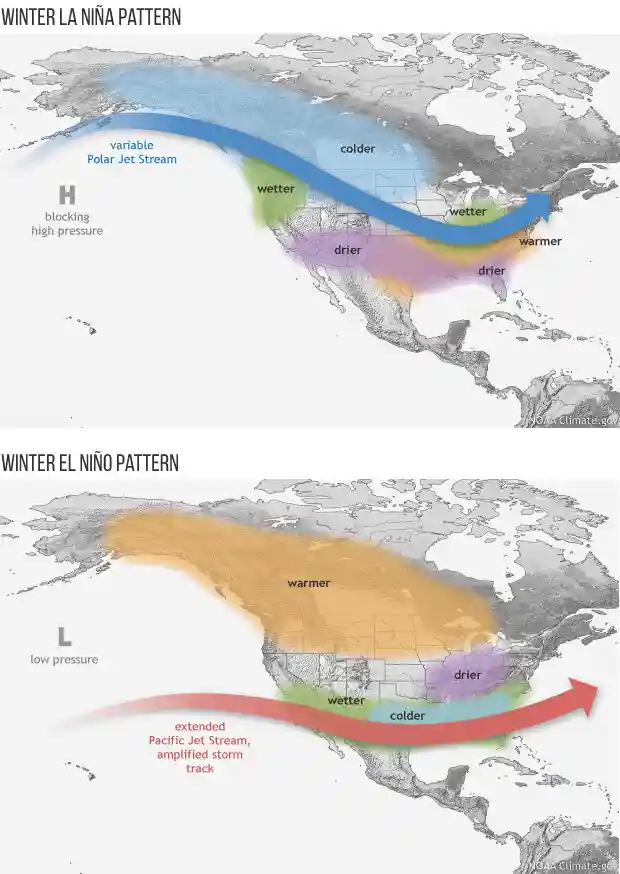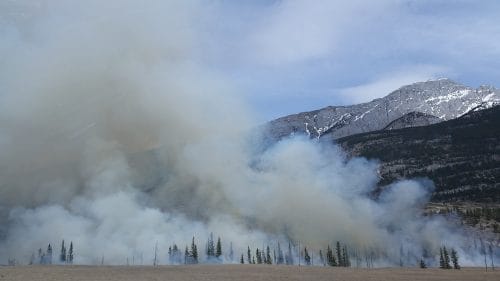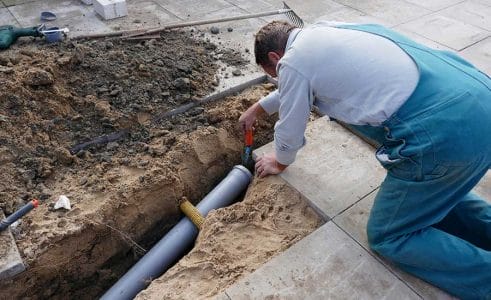What Are El Niño and La Niña?
El Niño and La Niña are global climate patterns that tend to occur every few years.
Both El Niño and La Niña can drastically affect weather around the globe, with different regions experiencing different effects, such as increased rainfall or drought-like conditions.
In the United States, the weather effects from both El Niño and La Niña can lead to disasters like floods, fires, and droughts.
Because of this, it’s helpful to know the difference between El Niño and La Niña and how each can affect the weather in your region.
In this article, we’ll explore the differences between El Niño and La Niña, how long each lasts, and the various effects each has on the weather in different parts of the country.
El Niño Vs. La Niña: What’s The Difference?
El Niño and La Niña are opposite phases of the El Niño-Southern Oscillation (ESNO) climate phenomenon, with El Niño being the warm phase and La Niña being the cool phase. The ENSO climate pattern irregularly shifts back and forth every two to seven years, resulting in fluctuating temperatures among Pacific Ocean currents, particularly the currents called trade winds. These shifts in currents and ocean surface temperatures can disrupt both wind and rainfall patterns across the tropics, which, in turn, affect weather around the globe.
In normal conditions, the trade winds blow westward and bring warm water from South America to Asia. Cold water rises upward in a process known as “upwelling,” replacing the warm water. When El Niño and La Niña are in effect, the trade winds weaken and increase, respectively, each causing distinct effects on the weather.
What Is El Niño?
When El Niño occurs, the trade winds weaken, causing warm water to be pushed back east toward America’s western coast. The phenomenon got its name from South American fishermen who noticed the warmer water and referred to it as “El Niño de Navidad,” which means ‘the little boy of Christmas,’ because the phenomenon typically peaks in December.
How Does El Niño Affect The Weather In The United States?
El Niño can have a significant effect on the weather in the United States. With the warmer waters along the western U.S., the Pacific jet stream moves farther south than usual. This shift can result in increased precipitation and flooding throughout the southern U.S. and Gulf Coast. Conversely, the northern U.S. is usually both warmer and drier during El Niño.
How Often Does El Niño Occur?
El Niño does not occur annually, nor does it occur with any set regularity. El Niño events usually occur every two to seven years.
How Long Does El Niño Last?
Because El Niño is not on a regular schedule, its duration can change with each occurrence. Typically, El Niño lasts between nine and 12 months. However, there are records of El Niño events lasting for several years.
What Is An El Niño Winter?
Although El Niño usually lasts nine to 12 months, the effects of it often become most apparent during winter months, which is why you might hear about El Niño winter. In the southern U.S., having an El Niño winter means experiencing cooler and wetter weather than usual. Conversely, in the northern U.S., an El Niño winter means having warmer and drier weather than usual. Because these weather effects tend to peak during winter months, an El Niño winter can result in more floods across the Southern U.S. and an increased likelihood of wildfires in the northern and western U.S.
What Is La Niña?
La Niña is the opposite phase of El Niño. During La Niña events, Pacific trade winds increase, pulling more warm water away from the Americas and resulting in more upwelling of cold water along western coasts. La Niña means ‘little girl’ in Spanish.

These maps illustrate the typical impacts of El Niño and La Niña on U.S. winter weather. Typical means “common,” but not guaranteed because each event is unique. NOAA Climate.gov drawings, adapted from originals by the Climate Prediction Center.
How Does La Niña Affect The Weather In The United States?
La Niña has an opposite effect on the weather than El Niño. During La Niña, the Pacific jet stream shifts north. This shift results in colder and wetter weather conditions across the northern U.S. and Canada and warmer and drier conditions in the southern U.S. As such, southern states are more prone to droughts during La Niña events.
How Often Does La Niña Occur?
La Niña, like El Niño, is not an annual or regular event. However, La Niña events usually occur every two to seven years. Despite not having a regular timetable, La Niña typically occurs less frequently than El Niño.
How Long Does La Niña Last?
There is no set timeframe for how long La Niña can last. Usually, La Niña lasts somewhere between nine and 12 months. However, there have been instances where La Niña events have lasted several years.
What Is A La Niña Winter?
Like with El Niño, the weather effects of La Niña become most noticeable during winter months. Having a “La Niña winter” in the northern U.S. and Canada means winter weather will be colder and wetter, and flooding and severe snowstorms can also increase.
Recovering From Storm Damage With BELFOR
Both El Niño and La Niña can result in severe weather conditions across the country, from floods and blizzards to droughts and wildfires. This means that property owners in affected areas could be facing severe and costly damage to their homes or businesses.
If your home or business has been damaged by a storm or wildfire, you need experienced professionals to help you salvage your property and prevent further damage from occurring. We offer a wide range of property restoration services to help you overcome damage to your home or business.
Explore our service offerings or contact us today to learn more about our property restoration services.
.jpg)


